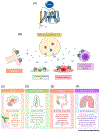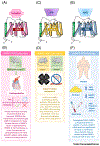Dawn of a New RAMPage
- PMID: 32115276
- PMCID: PMC7236817
- DOI: 10.1016/j.tips.2020.01.009
Dawn of a New RAMPage
Abstract
Receptor activity-modifying proteins (RAMPs) interact with G-protein-coupled receptors (GPCRs) to modify their functions, imparting significant implications upon their physiological and therapeutic potentials. Resurging interest in identifying RAMP-GPCR interactions has recently been fueled by coevolution studies and orthogonal technological screening platforms. These new studies reveal previously unrecognized RAMP-interacting GPCRs, many of which expand beyond Class B GPCRs. The consequences of these interactions on GPCR function and physiology lays the foundation for new molecular therapeutic targets, as evidenced by the recent success of erenumab. Here, we highlight recent papers that uncovered novel RAMP-GPCR interactions, human RAMP-GPCR disease-causing mutations, and RAMP-related human pathologies, paving the way for a new era of RAMP-targeted drug development.
Keywords: CGRP; G-protein-coupled receptor; adrenomedullin; coevolution; erenumab; receptor activity-modifying proteins (RAMPs).
Copyright © 2020 Elsevier Ltd. All rights reserved.
Figures



Similar articles
-
New Insights into the Regulation of CGRP-Family Receptors.Trends Pharmacol Sci. 2019 Jan;40(1):71-83. doi: 10.1016/j.tips.2018.11.005. Epub 2018 Dec 4. Trends Pharmacol Sci. 2019. PMID: 30527443 Review.
-
Receptor activity-modifying protein dependent and independent activation mechanisms in the coupling of calcitonin gene-related peptide and adrenomedullin receptors to Gs.Biochem Pharmacol. 2017 Oct 15;142:96-110. doi: 10.1016/j.bcp.2017.07.005. Epub 2017 Jul 11. Biochem Pharmacol. 2017. PMID: 28705698 Free PMC article.
-
Multiplexed analysis of the secretin-like GPCR-RAMP interactome.Sci Adv. 2019 Sep 18;5(9):eaaw2778. doi: 10.1126/sciadv.aaw2778. eCollection 2019 Sep. Sci Adv. 2019. PMID: 31555726 Free PMC article.
-
Elucidating the Interactome of G Protein-Coupled Receptors and Receptor Activity-Modifying Proteins.Pharmacol Rev. 2023 Jan;75(1):1-34. doi: 10.1124/pharmrev.120.000180. Epub 2022 Dec 8. Pharmacol Rev. 2023. PMID: 36757898 Free PMC article. Review.
-
RAMPs as allosteric modulators of the calcitonin and calcitonin-like class B G protein-coupled receptors.Adv Pharmacol. 2020;88:115-141. doi: 10.1016/bs.apha.2020.01.001. Epub 2020 Jan 27. Adv Pharmacol. 2020. PMID: 32416865 Free PMC article. Review.
Cited by
-
Structural insights into emergent signaling modes of G protein-coupled receptors.J Biol Chem. 2020 Aug 14;295(33):11626-11642. doi: 10.1074/jbc.REV120.009348. Epub 2020 Jun 22. J Biol Chem. 2020. PMID: 32571882 Free PMC article. Review.
-
The WNT7A/WNT7B/GPR124/RECK signaling module plays an essential role in mammalian limb development.Development. 2022 May 1;149(9):dev200340. doi: 10.1242/dev.200340. Epub 2022 May 12. Development. 2022. PMID: 35552394 Free PMC article.
-
Biased Allosteric Modulators: New Frontiers in GPCR Drug Discovery.Trends Pharmacol Sci. 2021 Apr;42(4):283-299. doi: 10.1016/j.tips.2020.12.005. Epub 2021 Feb 10. Trends Pharmacol Sci. 2021. PMID: 33581873 Free PMC article. Review.
-
Alpha-Calcitonin Gene Related Peptide: New Therapeutic Strategies for the Treatment and Prevention of Cardiovascular Disease and Migraine.Front Physiol. 2022 Feb 11;13:826122. doi: 10.3389/fphys.2022.826122. eCollection 2022. Front Physiol. 2022. PMID: 35222088 Free PMC article. Review.
-
Endosomal parathyroid hormone receptor signaling.Am J Physiol Cell Physiol. 2022 Sep 1;323(3):C783-C790. doi: 10.1152/ajpcell.00452.2021. Epub 2022 Aug 1. Am J Physiol Cell Physiol. 2022. PMID: 35912987 Free PMC article. Review.
References
-
- Garland SL (2013) Are GPCRs still a source of new targets? Journal of biomolecular screening 18 (9), 947–66. - PubMed
-
- Venkatakrishnan AJ et al. (2013) Molecular signatures of G-protein-coupled receptors. Nature 494 (7436), 185–194. - PubMed
-
- McLatchie LM et al. (1998) RAMPs regulate the transport and ligand specificity of the calcitonin-receptor-like receptor. Nature 393 (6683), 333–339. - PubMed
-
- Christopoulos A et al. (2003) Novel receptor partners and function of receptor activity-modifying proteins. Journal of Biological Chemistry 278 (5), 3293–3297. - PubMed
Publication types
MeSH terms
Substances
Grants and funding
LinkOut - more resources
Full Text Sources
Research Materials

